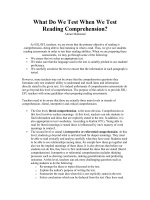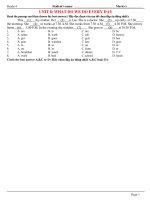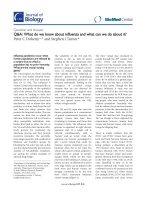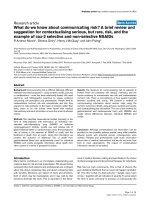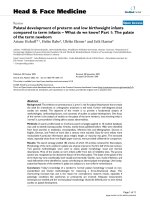What Do We Test When We Test Reading Comprehension
Bạn đang xem bản rút gọn của tài liệu. Xem và tải ngay bản đầy đủ của tài liệu tại đây (60.61 KB, 2 trang )
What Do We Test When We Test Reading
Comprehension?
Akmar Mohamad
As ESL/EFL teachers, we are aware that the primary objective of reading is
comprehension--being able to find meaning in what is read. Thus, we give our students
reading assessments in order to test their reading abilities. When we are preparing these
assessments, we may go through some of the following:
• We ensure that we select an appropriate text.
• We make sure that the language used in the text is suitably pitched to our students'
proficiency.
• We carefully scrutinise the text to ensure that the information in each paragraph is
tested.
However, some teachers may not be aware that the comprehension questions they
formulate only test students' ability to understand and recall ideas and information directly
stated in the given text. It is indeed unfortunate if comprehension assessments do not go
beyond this level of comprehension. The purpose of this article is to provide ESL/EFL
teachers with some guidelines when preparing reading assessments.
Teachers need to be aware that there are actually three main levels or strands of
comprehension--literal, interpretive and critical comprehension.
• The first level, literal comprehension, is the most obvious. Comprehension at this
level involves surface meanings. At this level, teachers can ask students to find
information and ideas that are explicitly stated in the text. In addition, it is also
appropriate to test vocabulary. According to Karlin(1971), "being able to read for
literal meanings ie stated ideas is influenced by one's mastery of word meanings in
context'.
• The second level or strand is interpretive or referential comprehension. At this
level, students go beyond what is said and read for deeper meanings. They must be
able to read critically and analyse carefully what they have read. Students need to
be able to see relationships among ideas, for exmple how ideas go together and also
see the implied meanings of these ideas. It is also obvious that before our students
can do this, they have to first understand the ideas that are stated (literal
comprehension). Interpretive or referential comprehension includes thinking
processes such as drawing conclusions, making generalizations and predicting
outcomes. At this level, teachers can ask more challenging questions such as asking
students to do the following:
o Re-arrange the ideas or topics discussed in the text.
o Explain the author's purpose of writing the text.
o Summarize the main idea when this is not explicitly stated in the text.
o Select conclusions which can be deduced from the text t!hey have read.
• Finally, the third level of comprehension is critical reading whereby ideas and
information are evaluated. Critical evaluation occurs only after our students have
understood the ideas and information that the writer has presented. At this level,
students can be tested on the following skills:
o The ability to differentiate between facts and opinions.
o The ability to recognize persuasive statements .
o The ability to judge the accuracy of the information given in the text.
Conclusion
Although comprehension takes place at several levels, mastery at any one level is not a
prerequisite to comprehension at another level. Furthermore, the reading skills for each
level or strand cut across ages; they are relevant to young readers in primary schools,
secondary school students right up to students at tertiary level. EFL/ESL teachers also need
to keep in mind that the three levels are not distinct . Dividing comprehension into literal,
referential and critical strands is only intended as a guide for teachers when preparing
reading assessments. Studies have shown that teachers tend to ask their students mainly
literal comprehension questions. They need to be aware that there is more to reading than
just the basic skills of reading and recalling information.


